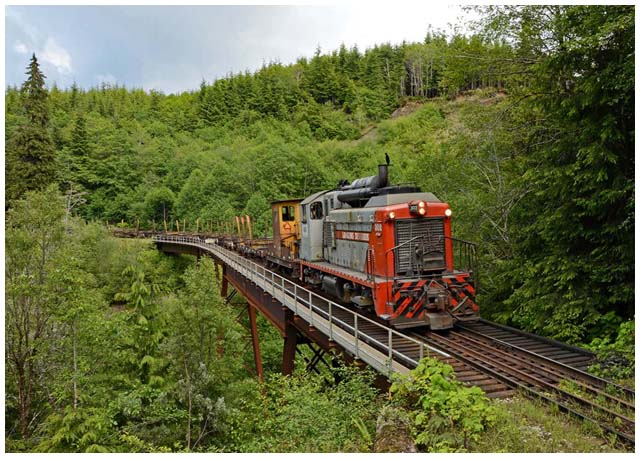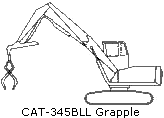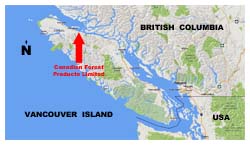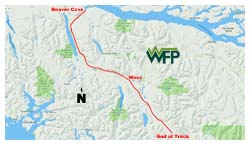

The Canadian Forest Products Limited (CanFor) logging railway might be the last logging railway still operating in Canada. According to Michael
Gaudet, their Supervisor of Railway Operations, "Its the last logging railway anywhere in North America!" The original railway was first
constructed in 1917 by the Nimpkish Timber Company with 2 geared steam engines and 6 miles of track. By 1925 the Wood & English Company had
constructed a large sawmill on the northern tip of Beaver Cove. Nimpkish Timber and another were purchased by
CanFor in 1944. Today the company has 400 cars and four locomotives running over 76 miles of track. CanFor was acquired by Western Forest Products
in 2006 who subsequently renamed the line from CanFor's "Englewood Logging Division" to the "Englewood Railway". This article is
based on a visit to the area made on the 3rd and 4th of February 2003.
 Vancouver Island is a huge island located off the west coast of British
Columbia, Canada. One main highway runs north from Victoria at its southern tip to Port Hardy. The northern tip of the island at Cape Scott is still
another 40 miles as the crow flies but is inaccessible by road. Between lies wilderness.
Vancouver Island is a huge island located off the west coast of British
Columbia, Canada. One main highway runs north from Victoria at its southern tip to Port Hardy. The northern tip of the island at Cape Scott is still
another 40 miles as the crow flies but is inaccessible by road. Between lies wilderness.
CanFor is headquartered at Woss, about six hours drive from Victoria. The highway, number 19, cuts through many populated towns en route such as Duncan, Ladysmith, Nanaimo, Parksville, Courtenay, and Campbell River. North of Campbell River the towns disappear into a sea of mountains and forests. In February the temperature was comfortable during the day but frost covered all surfaces in the early morning hours. In the shadows, where the warmth of the sun's rays could not reach, it lasted most of the day. The higher mountain peaks, mainly above the tree line, were topped with fresh snow. The days were perfectly clear and the stars at night, uncountable.
The railway, known as CanaFor's Englewood Logging Division, blankets the land like the branches of a tree. Its root lies at Beaver Cove on Johnstone Strait just south of the tip of Malcolm Island. From there the mainline runs south sprouting branches to various sidings and reloads along its route through the Nimpkish Valley to Woss and its final destination, Vernon Camp. Surprisingly, this mainline totals 56 miles in length, solely for the purpose of hauling harvested logs from the forests to Beaver Cove.
I didn't visit any areas where trees were harvested due to concentrating on the railway and it's operations. After cutting, logs are loaded onto
log trucks for transport to reloads such as the one depicted here, named Camp A Reload. It is easily accessible two kilometers north of Zeballos
Junction on Highway 19. Logs are lifted from each truck as it arrives at the reload by a large metal hoist reminiscent of a logging
A Frame. The cables are pulled to shift the load over the waiting empty log bunks (railway log cars) then lowered onto the car. The lifting
harness is then swung back to pick up the rear portion of the logging truck and place it onto the truck directly behind the cab in piggyback
fashion. The truck then drives off to pick up another load. A cable and winch assembly pulls the cut of log bunks forward one car length. The hoist
crew takes a break to wait for another truck load. Once that string of log bunks is full a locomotive is required to switch the small yard. On this
particular day a string of cars from another reload was added to make one large trainload. Pulled by locomotives 301 and 304 this train headed
downgrade to the dryland sort at Beaver Cove followed by a rather unique caboose. Typically, 3 loaded trains per day are run on the line with the
empty log bunks brought back up the hill to the sidings and reloads where they are needed. While a few local companies purchase directly from the
dryland sort at Beaver Cove the majority of logs are shipped by water to Vancouver.
 Upon arrival at Beaver Cove a great deal of work is required to process a loaded train. Beaver Cove is the sight of
their dryland sort. Several pieces of machinery are utilized to unload and transport logs. The primary tool for unloading log bunks is the
Wagner L-120 Log Stacker. This large machine is similar to the familiar "Front-End Loader" seen in construction work about this country.
It differs in that it has three points where wheels contact the ground with the rear set of wheels being steerable. The entire load on a log bunk is
lifted at one go with huge grips on the front of this machine. It is capable of lifting 60 tons.
Upon arrival at Beaver Cove a great deal of work is required to process a loaded train. Beaver Cove is the sight of
their dryland sort. Several pieces of machinery are utilized to unload and transport logs. The primary tool for unloading log bunks is the
Wagner L-120 Log Stacker. This large machine is similar to the familiar "Front-End Loader" seen in construction work about this country.
It differs in that it has three points where wheels contact the ground with the rear set of wheels being steerable. The entire load on a log bunk is
lifted at one go with huge grips on the front of this machine. It is capable of lifting 60 tons.
The logs are then spread out on the ground. Log Graders (humans) then mark the logs for one of 35 specific sorts. Sorts are made for specific
mills by species, lumber recovery, size, and quality.
 An
additional piece of self-propelled machinery working the dryland sort is the CAT-345BLL. It is an excavator that has been converted to a log loader
by changing the boom and stick, adding the grapple, and raising the cab on a riser for better visibility. CanFor also has 2 more of these machines
that work in the forest. It looks somewhat like a tracked Back-Hoe with the shovel replaced by a small grapple. The machine is used to bundle logs
into specific sorts.
An
additional piece of self-propelled machinery working the dryland sort is the CAT-345BLL. It is an excavator that has been converted to a log loader
by changing the boom and stick, adding the grapple, and raising the cab on a riser for better visibility. CanFor also has 2 more of these machines
that work in the forest. It looks somewhat like a tracked Back-Hoe with the shovel replaced by a small grapple. The machine is used to bundle logs
into specific sorts.
 For
moving sorted groups of logs the four-wheeled CAT 980G Wheel Loader is used that's similar to a Front-End loader. It utilizes a grapple larger than
the CAT-345BLL but smaller than the Wagner L-120. Various concrete bunks are permanently placed about the area to receive groups of sorted logs.
When a concrete bunk is full the Wagner L-120 carries the complete load to the scaling area where the logs are measured and assessed for
value.
For
moving sorted groups of logs the four-wheeled CAT 980G Wheel Loader is used that's similar to a Front-End loader. It utilizes a grapple larger than
the CAT-345BLL but smaller than the Wagner L-120. Various concrete bunks are permanently placed about the area to receive groups of sorted logs.
When a concrete bunk is full the Wagner L-120 carries the complete load to the scaling area where the logs are measured and assessed for
value.
 Following that, logs are moved to the strapping bunks where metal straps are applied to keep the bundle together. The
log bundles are weighed and dumped into the ocean, oddly enough named the "booming ground", where logs are assembled into booms or rafts.
Bundles of the same type are joined together to form a raft. Each raft is then towed to East Bay to await final assembly and towing. Twelve rafts
tied together make a boom for the tugboat trip to Vancouver. Assembly of these rafts is performed by small West Coast Sidewinder tugs and other tugs
located at Beaver Cove.
Following that, logs are moved to the strapping bunks where metal straps are applied to keep the bundle together. The
log bundles are weighed and dumped into the ocean, oddly enough named the "booming ground", where logs are assembled into booms or rafts.
Bundles of the same type are joined together to form a raft. Each raft is then towed to East Bay to await final assembly and towing. Twelve rafts
tied together make a boom for the tugboat trip to Vancouver. Assembly of these rafts is performed by small West Coast Sidewinder tugs and other tugs
located at Beaver Cove.
Wood quality varies with tree species and with the conditions where the tree grows. Certain qualities make one species better for a product than another. Here are some examples:
- Western red cedar - Rot resistant, durable and light weight it is used for house siding, outdoor furniture, decking, fencing, and
roofing shakes. Its low relative density makes it a good thermal insulator so it is used in saunas;
- Yellow cedar - is a yellow colour and has a straight grain. It is rot resistant and used in boat building and
carving;
- Lodgepole pine - A hard stiff wood used for lumber, plywood, panelling, doors, windows, furniture, railway ties, and fence posts.
Note: The Englewood Railway does not use creosoted ties;
- Hemlock - has an even grain and resists scraping. It may be found in doors, windows, staircases, ladders, construction, and pulp. Its
special uses include wood turnings, broom handles, pallets, and rails;
- Douglas fir - exceptionally hard, stiff, and durable, it is found in heavy duty construction such as wharves, trestles, bridges, and commercial buildings.
Locomotives - CanFor's railway motive power is presently comprised of 4 locomotives. 3 General Motors (GMD) diesel-electric locomotives purchased new in 1956, numbers 301 and 302 are SW1200RSu, 303 is a SW1200RS with Flexicoil trucks. The fourth unit, 304, is an EMD SW1200u ex-Georgia Pacific and Coos Bay Lumber. Three of these units, 301, 302, and 304, have been re-engined with Caterpillar CAT 3512 engines in a joint effort by Finning Caterpillar and the railway's locomotive shop. The V-12 engines are rated at 1,500 horsepower. The entire engine and generator package was replaced, the electrical system redone, and a new control system installed. This rebuilding necessitated moving the radiator fan above the top of the hood line to clear the engine and radiator compartment. A black coloured box was manufactured to hold the fan. Additionally, a very large muffler was added between the two air reservoirs mounted on top of the hood between the new radiator fan and the dynamic brake housing, just forward of the cab. These units are extremely quiet. The fourth unit, number 303, has not been re-engined and is held in operational condition as standby power.
Log Bunks - There are two basic types of log carrying cars. One is the typical log bunk or skeleton log car comprised of two trucks connected by a simple frame supporting the bunks that hold the logs. These are all steel construction. Wooden log bunks were not in evidence anywhere. The second type appears to be typical flat cars with bunks added to their frames for the support of logs.
Cabooses - Two cabooses were noted, both being of similar construction. One carried the newer red and silver paint scheme while the other
was yellow. A crew member occupies a caboose during train movements.
Steam Engine - The last steam engine to be used on the railway, number 113, is still on the property. Inoperable, it sits unprotected and
rusting in the open at Woss. Unfortunately there are no funds available to construct a shed. Number 113 is a 2-8-2 Mikado of 135 tons constructed by
the American Locomotive Company (ALCO) in 1920. In 1948 Alberni Pacific brought it to Chemainus for logging service. Canadian Forest Products bought
it in 1953 because it had a relatively new (1938) boiler. It was used in logging until 1966 and for special
occasions until 1976 when it was put on display at Woss. In June of 1988 it was hauled to the Nimpkish Shop for restoration. In August 1988
it steamed once more for the company's 50th Anniversary picnic. After pulling summer tours for a number of years it was taken out of service in
1994. It now sits by the company's locomotive department building at Woss coupled to the "The Grey Ghost", a silver painted ex-CPR
smooth-sided coach.
26 Jul 2012 - Speeders Back on Alberni Rails
4 Nov 2014 - $10,000 Donation Powers Historic Locomotive's Move to Alberni
28 Jan 2016 - Railway Logging and a Fascination with Trains
28 Jun 2016 - Speeders Ride the Rails
Canadian Forest Products
Western Forest Products
Englewood Railway Roster
Washout At East Fork
Early CanFor Photos
Pentrex Video
 Vancouver Island Railroads
Robert D. Turner
1997
Sono Nis Press
Perfectbound
186 pages, $31.87 (Amazon)
Another comprehensive and excellent work by this well known Canadian author of transportation books. First edition 1973, second edition 1997.
Second edition cover shown.
Vancouver Island Railroads
Robert D. Turner
1997
Sono Nis Press
Perfectbound
186 pages, $31.87 (Amazon)
Another comprehensive and excellent work by this well known Canadian author of transportation books. First edition 1973, second edition 1997.
Second edition cover shown.




